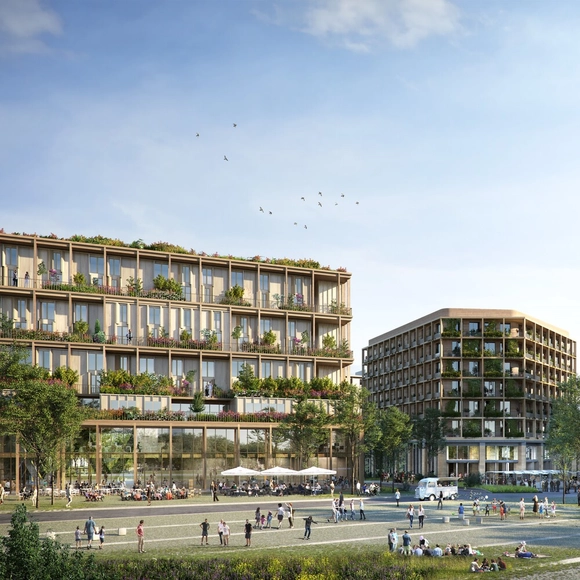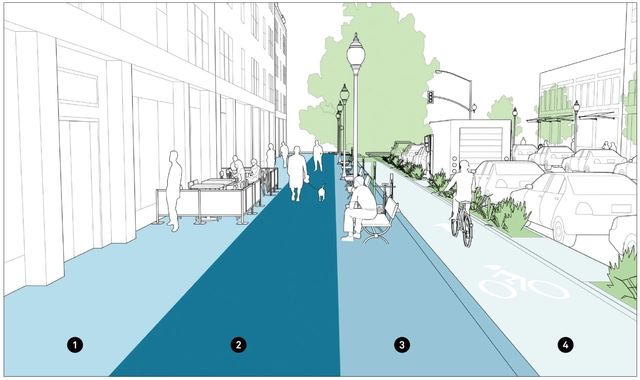
A step-by-step outline on how to turn 3D models in SketchUp into 2D documentation through LayOut.


A step-by-step outline on how to turn 3D models in SketchUp into 2D documentation through LayOut.

In a new show at Kunst Haus Wien in Vienna, the Austrian artist continues his investigation of architecture where few civilians tread.
Gregor Sailer’s quest for unusual structures and buildings takes him to some of the most extreme reaches of human civilization — from military field exercise centers in the USA and Europe to a mining center near Chuquicamata in the Atacama Desert to Arctic snow fields.

Sudden lifestyle changes driven by the ongoing pandemic forced many to become well aware that the space they inhabit directly influences their well-being. Living and working spaces have adapted accordingly, incorporating features that promote calmness, health and sensitivity through innovation. Recognizing these new priorities, this year’s ICONIC AWARDS: Innovative Interior honoured the most important international design innovations, focusing on products that have special relevance in the context of the pandemic. The German Design Council’s prestigious award is regarded as the trend barometer of the interior design industry, showcasing outstanding appliances and furnishings that respond to four current concepts: Smart together, Less is more, Homo movens, and Material innovation.

Site analysis is a crucial first step in creating a viable building design. Considering site location, topography, zoning regulations, traffic conditions, and climate allows a designer to maximize opportunities and anticipate potential issues. The following four factors are crucial in getting the most value out of site analysis.

Each year, TIME publishes TIME100 Next, a list, inspired by its flagship TIME100, seeking to recognize 100 people from all industries around the world whose careers are on the rise. As a result, the 2022 TIME100 Next list features high-profile musicians and medical professionals, government officials, movement leaders and whistleblowers along with top CEOs, all selected by TIME journalists. However, in this year's list it is possible to recognize the only professional that represents the guild: the Mexican architect Frida Escobedo.

As part of a Tec de Monterrey initiative, this year the First Prize of the 213th Traditional Tec Draw is being held with a work by the Chilean architect who won the 2016 Pritzker Prize, Alejandro Aravena. Elemental House, is the second of the Houses of the 75th Anniversary of Sorteos Tec, which is celebrated this year.

After photographing architectural studios in Berlin, Marc Goodwin has captured the spaces of 26 offices between the German cities of Frankfurt, Stuttgart, and Munich, including Schneider+Schumacher, Blocher Partners, Asp Architekten, Behnisch Architekten, Laboratory for Visionary Architecture, Henn, and Auer Weber Assoziierte to name a very few.
Continuing his work on the Atlas of Architectural Atmospheres, Archmospheres, Goodwin has collected so far, images of studios from cities around the world, more specifically from Madrid, Panama City, Dubai, London, Paris, Beijing, Shanghai, Seoul, Barcelona, Los Angeles, Istanbul, and so many others.

Generation Z comprises people born after 1995. They grew along with the popularization of the internet and interact with the world by integrating all forms of available technology.
The diversity of available media, the speed in information traffic, the interactivity in the virtual environment and the daily use of these technological assets common today, influence the behavior of individuals of this generation, inspiring versatility, agility and curiosity.

Architecture is often an ambitious profession, with many architects hoping to positively contribute to the social life of the communities, create emotional responses, and add moments of delight and solace to our daily experiences. However, market forces have a way of applying constant pressure on this field, often being the deciding factor in many design choices. Costs and economic value are generally a good indicator of how, when, and to what extent certain materials are being used: the standard rule is the cheaper, the better. But materials are only part of the equation. Site labor, management, and design costs are also considered, depicting a complex picture of the balance between the cost of materials and the cost of labor and its effect on the architectural product.

The Second Studio (formerly The Midnight Charette) is an explicit podcast about design, architecture, and the everyday. Hosted by Architects David Lee and Marina Bourderonnet, it features different creative professionals in unscripted conversations that allow for thoughtful takes and personal discussions.
A variety of subjects are covered with honesty and humor: some episodes are interviews, while others are tips for fellow designers, reviews of buildings and other projects, or casual explorations of everyday life and design. The Second Studio is also available on iTunes, Spotify, and YouTube.
This week David and Marina are joined by Architect Greg Warner, Principal and Founder of Walker Warner Architects to discuss growing up in Hawaii and its influence on his professional career; co-founding his office and its growth; working in Hawaii; the responsibilities of a principal and the importance of leadership; his philosophy and approach to projects; and more.

In the architectural conversations we are having in today’s world, conversations on materials are widespread. There is discussion on the viability of concrete in the contemporary context, how timber can be more sustainably sourced, and on how biodegradable materials such as bamboo should be more common sights in our urban environments.
But we also need to be talking about what goes into these buildings – that is, the furniture that decorates, enhances, and makes habitable the buildings around us. The materials used to craft these objects have constantly evolved over centuries, and as we approach the end of 2022, it’s worth asking – what does the future hold for what our furniture will be made from?

Looking around, it is clear that the world is developing at a rapid rate, and so are cities. Architects and designers inevitably take on the challenge of building better cities and homes, so time needs to be properly allocated for efficiency. After all, in this industry, time really is money.
For years architects have been accustomed to working in a conventional way: they stick with traditional offline renderers and wait until the modeling part is all done to start rendering from scratch.
This is where software like D5 Render comes in, to resolve such problems and change the game. The market is growing and shifting, and so should the tools architects use.

This article was originally published on Common Edge.
In a time of global unrest, rising intolerance, and, some might argue, increasing secularization, is the campus chapel relevant anymore? Might it disappear altogether? As it turns out, campus sacred space appears to be transforming to play a more important role as many universities focus on educating their students to be more globally aware.

Wooden elements have the power to add warmth to a space or building. Through their shades, textures and rustic look, wooden surfaces tend to stand out, especially when used alongside more neutral and sober materials. In the Aldapeta María Ikastetxea School, a project developed by IDOM in the city of San Sebastian, Spain, the architects used the material in a particularly interesting way. Wood panels brought visual comfort and warmth to the building, whose material palette is limited, focusing especially on the use of glass, steel and exposed concrete.

Climate change is becoming more and more real every day: all over the world, we are witnessing a clear increase in climate disasters. Moreover, the latest IPCC report warns us of possible “tipping points” from which the climate transition could become not gradual, but sudden and irrevocable.

The relationship between architecture and nature is complex. If, on the one hand, we enjoy framing nature as art in our homes; on the other hand, we try at all costs to avoid the presence of obstructive "real" nature in our walls and structures, which can be damaged by roots and leaves. At the same time, we use green roofs, vertical gardens and flower boxes to bring cities closer to nature and improve people's wellbeing; but we also construct buildings with materials that are completely dissociated from fauna and flora. Although the advancement of biomaterials and new technologies is gradually changing this, we should nevertheless ask ourselves whether the structures and buildings we occupy need to be separated from the nature that surrounds them. This was the question that led researchers at the University of Virginia (UVA) to develop geometrically complex 3D-printed soil structures on which plants could grow freely.

Domenig was one of Austria’s most radical architects and a major influence on many of architecture’s leading lights but remains widely unknown. A new exhibition aims to change that.

Architecture is not simply building. Over 2,000 years ago, Roman architect Marcus Vitruvius Pollio defined two base realities in building: “Firmness” (Safety) and “Commodity” (Use) and then offered what turns building into architecture: “Delight” (Beauty).
“Firmness” has been recoined in this century as “Resilience”. After being unscathed in five hurricanes over thirty years, does this building have “Delight” beyond its “Firmness”? The property of “Commodity” is found in any design’s usefulness and fit: is this archive, in constant use, have “Delight” beyond its “Commodity”?

Interior courtyards can be found in various types of traditional architectures around the world, especially in warmer climates. They can be classified as introverted, safe, and even sacred spaces in some cultures. They can also be gathering places and, above all, provide greater contact with nature while providing light and ventilation to home interiors. To properly design these spaces and create a functional relationship between the inside of a house and its courtyard, it is important to use appropriate doors and openings. In this article we highlight 5 projects that use sliding glass doors for the seamless integration of both spaces.

Whether you live in an urban, suburban, or rural area, there’s a good chance that using a sidewalk, in some capacity, is part of your everyday routine. Whether crossing over a sidewalk to get to your car in a parking lot or walking several blocks on your commute to your office downtown, sidewalks are critical for creating safe places for pedestrians away from the streets. But what happens when cities don’t take ownership over sidewalk maintenance, and they’re left to be protected by the people who just use them?